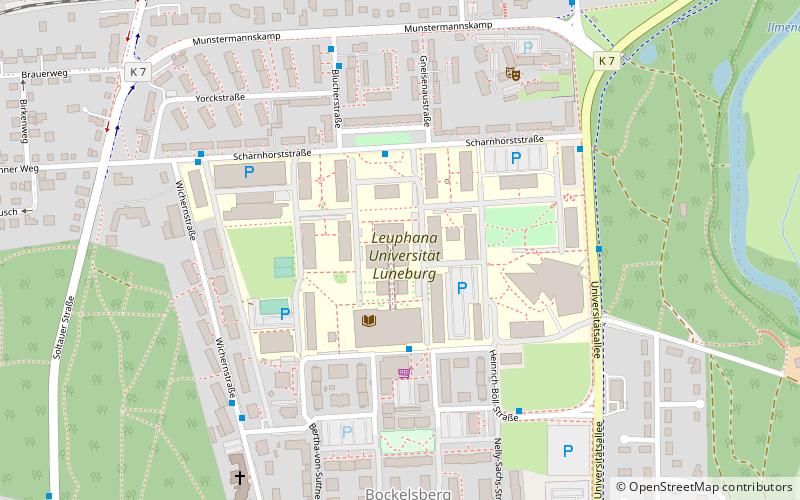Lüneburg: Sightseeing
Places and attractions in the Sightseeing category
St. John's Church
The Church of John the Baptist is the oldest Lutheran church in Lüneburg, Germany. It is located in the city centre. Lüneburg is on the European Route of Brick Gothic and the church is an example of this style.
Lüneburg Water Tower
Water tower with tours and exhibitions Lüneburg Water Tower is a water tower in the southeastern part of the Lüneburg old town in Lower Saxony, Germany, built by the architect Franz Krüger, from designs by Richard Kampf. Its erection was initiated on 3 October 1905, and the tower was taken into use in November 1907.
St. Michaelis
St. Michaelis is one of the main churches in Lüneburg, Lower Saxony, Germany. It was first an abbey church of the former monastery of Benedictines, built from 1376 in brick Gothic style. It became Lutheran during the Reformation. Johann Sebastian Bach was for two years a pupil at the school of St. Michaelis.
Kalkberg
The Lüneburg Kalkberg is the cap rock of a salt dome in the western part of the German town of Lüneburg. The Kalkberg was a gypsum mine during the middle ages, but is today a Naturschutzgebiet and a common meeting place for city residents.
Lüne Abbey
Lüne Abbey is a former Benedictine nunnery in the Lower Saxon town of Lüneburg. Today it is a Protestant Lutheran convent and is managed by the Klosterkammer Hannover. The current abbess is Reinhild Freifrau von der Goltz.
German Salt Museum
The German Salt Museum in the German town of Lüneburg, on the site of the old production facilities of the Lüneburg Saltworks when it was closed in 1980. In 1991, it won the Council of Europe Museum Prize.
Ostpreußisches Landesmuseum
The East Prussian Regional Museum in Lüneburg, Lower Saxony in Germany, was established 1987 on the basis of the East Prussian Hunting Museum created by forester Hans Loeffke.
St. Nicolai
St. Nicolai is a church and Lutheran parish in Lüneburg, Lower Saxony, Germany. It is one of three main churches in the town, all built in brick Gothic style. The church, dedicated to St. Nicholas, is a basilica with three naves, built from 1407 to 1440. It features a "star" rib vault that is unique in Northern Germany.
Am Sande
Am Sande square is located in the city center of Lüneburg. It is surrounded by predominantly medieval town houses with their Gothic stepped and curved Baroque scroll gables. The source of the IDs and the descriptions is the Denkmalatlas...
Museum Lüneburg
The Museum Lüneburg deals with the cultural landscape of the Hanseatic city of Lüneburg in Lower Saxony and its surroundings. Exhibits of natural history, cultural history and archaeology are presented.
Old Town Hall
Lüneburg City Hall is an example of medieval and early modern secular architecture in northern Germany. It was built around 1230, was repeatedly expanded over the centuries and is still the headquarters of the council and administration of the...
St. Mary's Church
Sankt Marien is the Roman Catholic parish church in Lüneburg, a district town in Lower Saxony. The parish belongs to the deanery of Lüneburg of the diocese of Hildesheim. Dedicated to the patrocinium of the Virgin Mary, conceived without original...
Rathaus Lüneburg
Lüneburg City Hall is an example of medieval and early modern secular architecture in northern Germany. It was built around 1230, was repeatedly expanded over the centuries and is still the headquarters of the council and administration of the...
Leuphana Universität Lüneburg
Leuphana University Lüneburg is a public university in Lüneburg, Lower Saxony, Germany. Leuphana was founded in 1946 as a college of education. Leuphana established a unique university model within the German academic landscape that has received several awards.
Ökumenisches Gemeindezentrum St. Stephanus
St. Stephanus is the ecumenical center in Kaltenmoor, a district of the county seat Lüneburg in Lower Saxony. Named after Saint Stephen, its address is "St.-Stephanus-Platz 1".
Alter Kran
The Old Crane is a historic harbor crane at the former Ilmenau Harbor in Lüneburg. Built in 1797, the crane, which at the time was one of the most powerful in all of northern Germany, still characterizes the image of the water district and is...
Map























